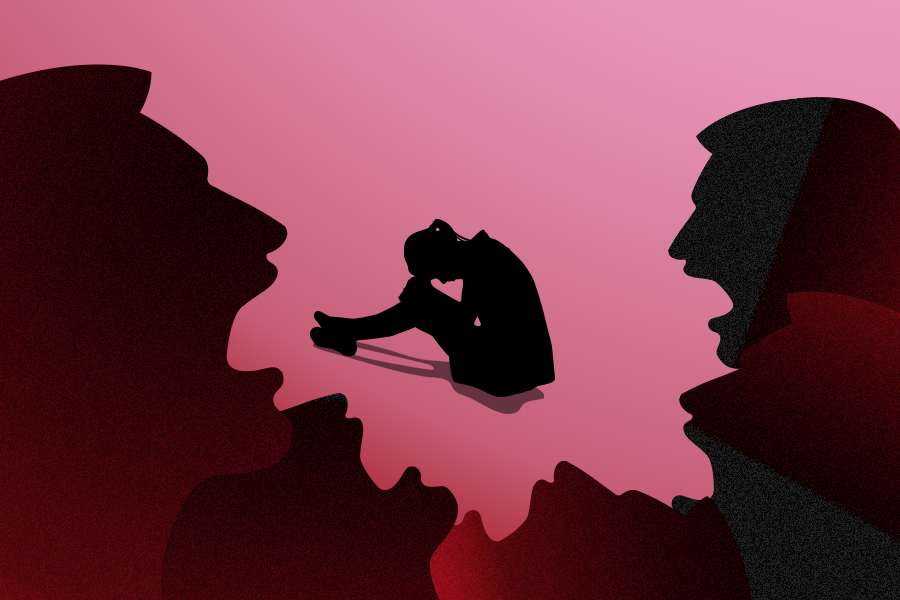Emotional abuse can take a catastrophic toll on a relationship and the health of anyone, of any gender, subjected to it. But it can also be very confusing to identify.
While physical violence leaves visible signs, emotional abuse is more subtle. Victims often say they didn’t even realize it was happening until after the fact. But in the #MeToo era, rife with examples of the complex ways abusers exercise control, stories of emotional abuse are suddenly everywhere.
Minnesota Rep. Keith Ellison, who is also running for Minnesota attorney general, denied allegations after his ex-girlfriend Karen Monahan stepped forward to detail a history of what she calls “narcissistic abuse” in their former relationship.
By her account to the New York Times, Ellison cheated and lied, which led to “blowout arguments.” He allegedly gaslit her — a term for manipulating someone to alter their perception of reality — and at one point “shouted profanities at her while trying to drag her off a bed.”
Comedian and TV host Chris Hardwick faced allegations of sexual and emotional abuse against his former girlfriend, Chloe Dykstra, who wrote on Medium that she was pressured to submit to unwanted sex and other controlling behavior, like how much alcohol she could drink (none) and how many male friends she could have (none).
This week, British reality show Love Island contestant Adam was so contemptuous and callous to fellow contestant Rosie when he dumped her, a domestic abuse charity in the U.K., Women’s Aid, released a statement warning women of the red flags in his behavior:
On the latest series of Love Island, there are clear warning signs in Adam’s behavior. In a relationship, a partner questioning your memory of events, trivializing your thoughts or feelings, and turning things around to blame you can be part of pattern of gaslighting and emotional abuse.
The litany of accounts of Harvey Weinstein’s sexual assaults always include emotional abuse, too. The two-minute tape of Weinstein manipulating, pressuring and gaslighting model Ambra Battilana Gutierrez into sex is being called a master class in emotional abuse.
Emotional abuse is just as common and complex in families. In a new memoir, Lisa Brennan-Jobs details a tumultuous upbringing with her charismatic, wealthy and famous father, Steve Jobs, who spent years refusing to recognize his firstborn. His behavior isn’t directly described as emotional abuse. But according to the New York Times review,
Steve demands absolute fealty: He pressures Lisa to change her last name to his (she adds it with a hyphen) and insists that she not see her mother for six months. Lisa cries herself to sleep out of grief and guilt about abandoning Chrisann [Brennan]. She is made to wash the dishes by hand each night (Steve refuses to repair the broken dishwasher), to sleep in a chilly room (he also refuses to repair the heater). …
Each of these stories only confirms in their own way why emotional abuse is harder to pin down or call out when it’s happening. With that kind of confusion surrounding the issue, it’s no wonder we often don’t know when to call it abuse versus, say, a “rocky relationship.”
Here are some defining aspects of what it is, and what it’s not.
It’s Not Just One Act, It’s a Pattern
What the above tales have in common is not the exact incidents, it’s the fact that they happen repeatedly over time in one form or another.
In an otherwise bad relationship or even a good one, you could have fights and say things you regret. You could insult someone in a moment of anger. You could temporarily pull back physically because you’re feeling upset, or hurt, or not close to your partner. You might shout. You might just disengage for an hour. You may have been deeply suspicious that someone has cheated, and you read their email to find out if they have. Once, you might have even thrown something when you got really upset.
Those could all point to risk factors leading toward an abusive situation. But is your relationship full of these stories? Is your partner distrustful, threatening and volatile? Are you with someone who shuts down and freezes you out for days to punish you? Normal conflict involves accountability, resolution and a vow to improve or omit the behavior. For it to be emotional abuse, it will keep violating normal boundaries, and it will keep happening. The abuser will never admit what they’re doing, because it’s “your fault,” not theirs.
This account of an emotionally abusive relationship, which interviews both partners in the story, proves that while individual anecdotes can seem like hallmarks of a bad relationship (he told her to lose weight; he criticized her surprise party for him; what he loved most about her was how much she was always trying to improve herself), it’s often only in the cumulative effect that you see the abuse. And it’s subtle enough that people who are emotionally abusive can always justify what was said or done as a moment of anger or a misunderstood concern.
The National Domestic Violence Hotline defines emotional abuse as a “pattern of behaviors used by one partner to maintain power and control over another partner in an intimate relationship.” The control can be economic, sexual or emotional.
Below is a graphic known as The Wheel Of Power & Control. The Duluth Model developed it in the 1980s to help combat domestic violence. This chart is widely used by DV prevention organizations to describe power & control scenarios to help victims identify dangerous relationships. pic.twitter.com/bYRkHGm4Zn
— Ashley Easter (@ashleymeaster) August 20, 2018
Its power and control wheel outlines the wide-ranging behaviors: the intimidation, minimizing, denying, blaming and threatening that fall under domestic abuse. The emotional abuse section lists:
- Putting her down
- Making her feel bad about herself
- Calling her names
- Making her think she’s crazy
- Playing mind games
- Humiliating her
- Making her feel guilty
It’s Everywhere and Can Happen to Anyone
Emotional abuse is considered to be present in roughly two thirds of relationships, with one third experiencing it chronically. It’s experienced by folks from every stripe. Even though it’s more likely to happen to women, we’re hearing an increasing number of stories of emotional abuse by women toward their male partners. Gay men in particular are at a higher risk for domestic violence than straight men.
And while women typically have less physical strength, money and power to coerce and control men, they can still be abusive. Their abuse, experts say, tends to include berating men at specific masculinity pain points: their earning power, looks, sexual abilities or anything regarding their role as providers or caregivers. That could mean telling a man he can’t please her sexually, or that he’s not a real man because he can’t live up to a past boyfriend or afford nicer things. It could be manipulation with sex, controlling the money (even if he makes it) and constant gaslighting.
It Doesn’t Have to Involve Physical Violence, Just Control
“When we talk about domestic violence, we’re talking about coercive control — not just physical violence, not just offenses that are criminal,” domestic violence expert Julie Owens told MEL in June. “Most of it isn’t even physical; it’s not against the law. It’s coercive control. It’s removing freedoms. It’s not just the man who beats his wife, but the man who doesn’t let her work, or has alienated all her friends.”
Like the Hardwick case, for instance, a partner might be uncomfortable with you hanging out with a certain friend, and you might even argue over it. But that’s not the same thing as demanding you no longer see someone—a directive without discussion, negotiation or compromise.
“While a normal couple may disagree about how to spend money, for example, an emotional abuser will make his partner feel as though she’s too stupid to understand the intricacies of finances,” Women’s Health notes.
A normal relationship could have times during an argument when a person isn’t feeling cuddly and close. In an emotionally abusive relationship, the partner withholds affection as a means of punishment and manipulation. When you point it out, they accuse you of being crazy or needy.
It Can Alternate With Caring, Charming Behavior
It can be confusing to identify emotional abuse because it often alternates with caring or charm, also sometimes called love bombing. That means big romantic gestures and lots of affection. That way, when the abuse surfaces, you’ll be confused and work to correct the story in your head. Anyone this terrible wouldn’t have also been so great, right?
It’s Subtle, but You Can Still Learn the Signs
The best way to tell if you’re in an emotionally abusive relationship is to consider how it feels to be in it: demoralizing, controlled and scared. You probably walk on eggshells with your partner so you don’t piss them off. You apologize a lot, or feel like a worthless piece of shit because they tell you you are one. You feel suffocated or controlled. And you feel hopeless.
Never mind that when you first got together it felt picture-perfect: Many emotional abusers are incredibly charming up front; otherwise you’d never put up with their shit. They wait until you’ve crossed a line into a more secure commitment before taking off the mask. And they reframe the abuse as charming — I wouldn’t need to control where you go and who you see if I weren’t so jealous because I love you so much, for instance.
In the End, You Just Need to Leave
Yes, an emotional abuser can change, but the likelihood of that happening if you stick around and endure it is nil. There’s only one way to deal with a person who constantly tramples your boundaries, and that’s to reset them and hold your ground. Emotionally abusive people will take everything you’ve got to give and never exhaust themselves. It’s up to you to leave or reclaim the rightful territory. Unfortunately, that almost always means leaving. Easier said than done, of course. But the first step is dialing this number.

